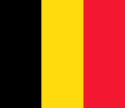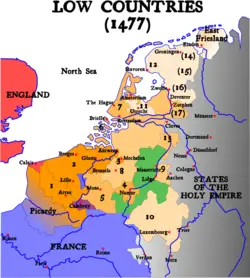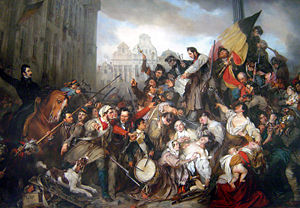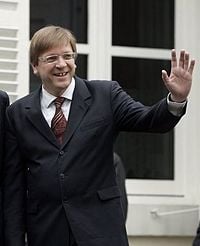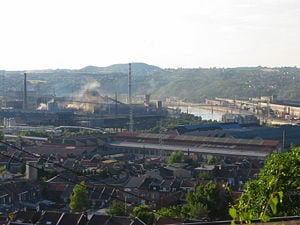Belgium
| Koninkrijk België Royaume de Belgique Königreich Belgien Kingdom of Belgium | |||||
| |||||
| Motto: Eendracht maakt macht (Dutch) L'union fait la force (French) Einigkeit macht stark (German) "Strength through Unity" | |||||
| Anthem: "The Brabançonne" (The Song of Brabant) | |||||
|
Location of Belgium (orange)
– on the European continent (camel white) – in the European Union (camel) [Legend] | |||||
| Capital | 22px Brussels 50°54′N 4°32′E | ||||
|---|---|---|---|---|---|
| Largest city | 22px Brussels 22px Antwerp1 | ||||
| Official languages | Dutch, French, German | ||||
| Government | Federal constitutional monarchy | ||||
| - King | Albert II | ||||
| - Prime Minister | Guy Verhofstadt | ||||
| Independence | |||||
| - Declared | October 4 1830 | ||||
| - Recognised | April 19, 1839 | ||||
| Accession to EU | March 25, 1957 | ||||
| Area | |||||
| - Total | 30,528 km² (139th) 11,787 sq mi | ||||
| - Water (%) | 6.4 | ||||
| Population | |||||
| - 2005 estimate | 10,419,000 | ||||
| - 2001 census | 10,296,350 | ||||
| - Density | 339.50 (2005)[1]/km² 886/sq mi | ||||
| GDP (PPP) | 2004 estimate | ||||
| - Total | $316.2 billion | ||||
| - Per capita | $31,400 | ||||
| HDI (2004) | |||||
| Currency | Euro (€)2 (EUR)
| ||||
| Time zone | CET (UTC+1) | ||||
| - Summer (DST) | CEST (UTC+2) | ||||
| Internet TLD | .be3 | ||||
| Calling code | +32 | ||||
| 1 Brussels is the largest urban area, Antwerp is the largest city with legal status. 2 Prior to 1999: Belgian franc. 3 The .eu domain is also used, as it is shared with other European Union member states. | |||||
The Kingdom of Belgium is a country in northwest Europe bordered by the Netherlands, Germany, Luxembourg and France and is one of the founding and core members of the European Union. Belgium has a population of over ten million people, in an area of around 30,000 square kilometres (11,700 square miles).
Straddling the cultural boundary between Germanic and Romance Europe, Belgium is linguistically divided. It has two main languages: 59% of its population, being 6.18 million people in the north, mainly in the region Flanders, speak Dutch (while Belgians of both major languages often refer to it as Flemish); French is spoken by 40%: 3.29 million in the southern region Wallonia and an estimated 0.88 million in the officially bilingual Brussels-Capital Region or 85-90% of its residents – thus a minority there speaks Dutch, its local language till shortly before Belgium's independence. Less than 1% of the Belgians, around 70,000 live in the German-speaking Community in the east of the Walloon Region. This linguistic diversity often leads to political and cultural conflict and is reflected in Belgium's complex system of government and political history.
Belgium derives its name from the Latin name of the northernmost part of Gaul, Gallia Belgica, named after a group of mostly Celtic tribes, Belgae. Historically, Belgium has been a part of the Low Countries, which also include the Netherlands and Luxembourg and used to cover a somewhat larger region than the current Benelux group of states. From the end of the Middle Ages until the seventeenth century, it was a prosperous centre of commerce and culture. From the sixteenth century until the Belgian revolution in 1830, the area at that time called the Southern Netherlands, was the site of many battles between the European powers, and has been dubbed "the battlefield of Europe"[2] or "the cockpit of Europe".[3] More recently, Belgium was a founding member of the European Union, hosting its headquarters, as well as those of many other major international organizations, such as NATO.
History
Over the past two millennia, the area that is now known as Belgium has seen significant demographic, political and cultural upheavals. The first well-documented population move was the conquest of the region by the Roman Republic in the 1st century B.C.E., followed in the 5th century by the Germanic Franks. The Franks established the Merovingian kingdom, which became the Carolingian Empire in the 8th century. During the Middle Ages, the Low Countries were split into many small feudal states. Most of them were united in the course of the 14th and 15th centuries by the house of Burgundy as the Burgundian Netherlands. These states gained a degree of autonomy in the 15th century and were thereafter named the Seventeen Provinces.
The history of Belgium can be distinguished from that of the Low Countries from the 16th century. The Eighty Years' War (1568–1648), divided the Seventeen Provinces into the United Provinces in the north and the Southern Netherlands in the south. The southern provinces were ruled successively by the Spanish and the Austrian Habsburgs. Until independence, the Southern Netherlands were sought after by numerous French conquerors and were the theatre of most Franco-Spanish and Franco-Austrian wars during the 17th and 18th centuries. Following the Campaigns of 1794 in the French Revolutionary Wars, the Low Countries—including territories that were never under Habsburg rule, such as the Bishopric of Liège—were overrun by France, ending Spanish-Austrian rule in the region. The reunification of the Low Countries as the United Kingdom of the Netherlands occurred at the end of the French Empire in 1815.
The 1830 Belgian Revolution led to the establishment of an independent, Catholic and neutral Belgium under a provisional government and a national congress. Since the installation of Leopold I as king in 1831, Belgium has been a constitutional monarchy and parliamentary democracy. Between independence and World War II, the democratic system evolved from an oligarchy characterised by two main parties, the Catholics and the Liberals, to a universal suffrage system that has included a third party, the Labour Party, and a strong role for the trade unions. Originally, French, which was the adopted language of the nobility and the bourgeoisie, was the official language. The country has since developed a bilingual Dutch-French system.
The Berlin Conference of 1885 agreed to hand over Congo to King Leopold II as his private possession, called the Congo Free State. In 1908, it was ceded to Belgium as a colony, henceforth called the Belgian Congo. Belgium's neutrality was violated in 1914, when Germany invaded Belgium as part of the Schlieffen Plan. The former German colonies Ruanda-Urundi—now called Rwanda and Burundi—were occupied by the Belgian Congo in 1916. They were mandated in 1924 to Belgium by the League of Nations. Belgium was again invaded by Germany in 1940 during the blitzkrieg offensive. The country was occupied until the winter of 1944-45 when it was liberated by Allied troops. The Belgian Congo gained its independence in 1960 during the Congo Crisis, and Ruanda-Urundi became independent in 1962.
After World War II, Belgium joined NATO and, together with the Netherlands and Luxembourg, formed the Benelux group of nations. Belgium is also one of the six founding members of the 1951 established European Coal and Steel Community, and the 1957 established European Economic Community and European Atomic Energy Community. Belgium hosts the headquarters of NATO and a major part of the European Union's institutions and administrations, including the European Commission, the Council of the European Union and the extraordinary and committee sessions of the European Parliament, as well as parts of its administration.
During the 20th century, and in particular since World War II, the history of Belgium has been increasingly dominated by the autonomy of its two main communities. This period saw a rise in intercommunal tensions, and the unity of the Belgian state has come under scrutiny.[4] Through constitutional reforms in the 1970s and 1980s, regionalisation of the unitary state had led to the establishment of a three-tiered system of federalism, linguistic-community and regional governments, a compromise designed to minimise linguistic tensions. Nowadays, these federal entities uphold more legislative power than the national bicameral parliament, whereas national government still controls nearly all taxation, over 80% of the finances of the community and region governments, and 100% of the social security.
Government and politics
Belgium is a constitutional popular monarchy and parliamentary democracy that evolved after World War II from a unitary state to a federation. The bicameral parliament is composed of a Senate and a Chamber of Representatives. The former is a mix of directly elected senior politicians and representatives of the communities and regions; while the latter represents all Belgians over the age of eighteen in a proportional voting system. Belgium is one of the few countries that has compulsory voting, thus having one of the highest rates of voter turnout in the world.[5]
The federal government, formally nominated by the king, must have the confidence of the Chamber of Representatives. It is led by the Prime Minister. The numbers of Dutch- and French-speaking ministers are equal as prescribed by the Constitution.[6] The King or Queen is the head of state, though with limited prerogatives. Actual power is vested in the Prime Minister and the different governments, who govern the country. The judicial system is based on civil law and originates from the Napoleonic code. The Court of Appeal is one level below the Court of Cassation, an institution based on the French Court of Cassation.
Belgium's political institutions are complex; most political power is organized around the need to represent the main language communities. Since around 1970, the significant national Belgian political parties have split into distinct components that mainly represent the interests of these communities. The major parties in each community, though close to the political centre, belong to three main political families: the right-wing Liberals, the social conservative Christian Democrats, and the Socialists as left-wing. Other important younger parties are the Green party and, especially in Flanders, the nationalist and far-right, Flemish Interest party. Politics is influenced by lobby groups, such as trade unions and business interests in the form of the Trade Federation of Enterprises in Belgium.
The current king, Albert II, succeeded King Baudouin (Boudewijn in Dutch) in 1993. Since 1999, Prime Minister Guy Verhofstadt from the VLD has led a six-party Liberal-Social Democrat-Greens coalition, often referred to as 'the rainbow government'. This was the first government without the Christian Democrats since 1958.[7] In the 2003 elections, Verhofstadt won a second term in office and has led a Liberal-Social Democrat coalition of four parties.[8] In recent years, there has also been a steady rise of the Flemish far right nationalist separatist party Vlaams Blok, meanwhile superseded by Vlaams Belang amidst allegations of racism promoted by the party.[9]
A significant achievement of the two successive Verhofstadt governments has been the achievement of a balanced budget; Belgium is one of the few member-states of the EU to have done so. This policy was applied by the successive governments during the 1990s under pressure from the European Council. The fall of the previous government was mainly because of the dioxin crisis,[10] a major food intoxication scandal in 1999 that led to the establishment of the Belgian Food Agency.[11] This event resulted in an atypically large representation by the Greens in parliament, and a greater emphasis on environmental politics during the first Verhofstadt government. One Green policy, for example, resulted in nuclear phase-out legislation, which has been modified by the current government. The absence of Christian Democrats from the ranks of the government has enabled Verhofstadt to tackle social issues from a more liberal point of view and to develop new legislation on the use of soft drugs, same-sex marriage and euthanasia. During the two most recent parliaments, the government has promoted active diplomacy in Africa,[12] opposed a military intervention during the Iraq disarmament crisis, and has passed legislation concerning war crimes. Both of Verhofstadt's terms have been marked by disputes between the Belgian communities. The major points of contention are the nocturnal air traffic routes at Brussels Airport and the status of the electoral district of Brussels-Halle-Vilvoorde.
Administrative divisions
| 150px Flemish Community (Dutch speaking) |
150px French Community (French speaking) |
150px German-speaking Community |
| 150px Flemish Region |
150px Walloon Region |
150px Brussels-Capital Region |
The country's constitution was revised on 14 July 1993 to create a unique federal state, based on three levels:
- The federal government, based in Brussels.
- The three language communities:
- the Flemish (i.e., Dutch-speaking) Community;
- the French (i.e., French-speaking) Community;
- the German-speaking Community.
- The three regions (which differ from the language communities with respect to the German-speaking community and the Brussels region):
- the Flemish Region;
- the Walloon Region; and
- the Brussels-Capital Region.
Conflicts between the bodies are resolved by the Court of Arbitration. The setup allows a compromise so distinctly different cultures can live together peacefully.
The Flemish Community absorbed the Flemish Region in 1980 to form the government of Flanders.[13] The overlapping boundaries of the Regions and Communities have created two notable peculiarities: the territory of the Brussels-Capital Region is included in both Flemish and French Communities, and the territory of the German-speaking Community lies wholly within the Walloon Region. Flemish and Walloon regions are furthermore subdivided in administrative entities, the provinces.
At the highest level of this three-tiered setup is the federal government which manages foreign affairs, development aid, defence, military, police, economic management, social welfare, social security transport, energy, telecommunications, and scientific research, limited competencies in education and culture, and the supervision of taxation by regional authorities. The federal government controls more than 90 per cent of all taxation. The community governments are responsible for the promotion of language, culture and education in mostly schools, libraries and theatres. The third tier is the Regional governments, who manage mostly land and property based issues such as housing, transportation etc. For example, the building permit for a school building in Brussels belonging to the public school system would be regulated by the regional government of Brussels. However, the school as an institution would fall under the regulations of the Flemish government if the primary language of teaching is Dutch, but under the French Community government if the primary language is French.
Geography, climate, and environment
Belgium, with a land area of 30 528 square kilometres (33,990 km² in total), has three main geographical regions: the coastal plain in the north-west, the central plateau, and the Ardennes uplands in the south-east. The coastal plain consists mainly of sand dunes and polders. Polders are areas of land, close to or below sea level that have been reclaimed from the sea, from which they are protected by dikes or, further inland, by fields that have been drained with canals. The second geographical region, the central plateau, lies further inland. This is a smooth, slowly rising area that has many fertile valleys and is irrigated by many waterways. Here one can also find rougher land, including caves and small gorges.Belgium shares borders with France 620 km, Germany 167 km, Luxembourg 148 km and Netherlands 450 km.
The third geographical region, called the Ardennes, is more rugged than the first two. It is a thickly forested plateau, very rocky and not very good for farming, which extends into northern France and in Germany where it is named Eifel. This is where much of Belgium's wildlife can be found. Belgium's highest point, the Signal de Botrange is located in this region at only 694 metres (2,277 ft).
The climate is maritime temperate, with significant precipitation in all seasons (Köppen climate classification: Cfb; the average temperature is 3 °C (37°F) in January, and 18° C (64 °F) in July; the average precipitation is 65 millimetres (2.6 in) in January, and 78 millimetres (3.1 in) in July).[14]
Because of its high population density and location in the centre of Western Europe, Belgium faces serious environmental problems. A 2003 report[15] suggested that the water in Belgium's rivers was of the lowest quality in Europe, and bottom of the 122 countries studied.
Economy
Densely populated, Belgium is located at the heart of one of the world's most highly industrialised regions. Currently, the Belgium economy is heavily service-oriented and shows a dual nature with a dynamic Flemish part and Brussels as its main multilingual and multi-ethnic centre and a GNP/person which is one of the highest in the European Union, and a Walloon economy that lags roughly one quarter behind (in GNP/person).
Belgium was the first continental European country to undergo the Industrial Revolution, in the early 1800s. Liège and Charleroi rapidly developed mining and steelmaking, which flourished until the mid-20th century. However, by the 1840s the textile industry of Flanders was in severe crisis and there was famine in Flanders (1846–50). After World War II, Ghent and Antwerp experienced a fast expansion of the chemical and petroleum industries. The 1973 and 1979 oil crises sent the economy into a prolonged recession. The Belgian steel industry has since experienced serious decline. This has been responsible for inhibiting the economic development of Wallonia.[16] In the 1980s and 90s, the economic centre of the country continued to shift northwards to Flanders. Nowadays, industry is concentrated in the populous Flemish area in the north.
By the end of the 1980s, Belgian macroeconomic policies had resulted in a cumulative government debt of about 120% of GDP. Currently, budget is in balance and public debt is equal to 87.53% of GDP (2006).[17] In 2005, the real growth rate of GDP was estimated at 1.5% while OECD's prognose for 2006 is 2.9%.[18]
Belgium has a particularly open economy. It has developed an excellent transportation infrastructure of ports, canals, railways and highways to integrate its industry with that of its neighbours. Antwerp is the second-largest European port. One of the founding members of the European Union, Belgium strongly supports the extension of the powers of EU institutions to integrate the member economies. In 1999, Belgium adopted the euro, the single European currency, which replaced the Belgian franc in 2002. The Belgian economy is strongly oriented towards foreign trade, in particular of high value-added goods. The main imports are food products, machinery, rough diamonds, petroleum and petroleum products, chemicals, clothing and accessories, and textiles. The main exports are automobiles, food and food products, iron and steel, finished diamonds, textiles, plastics, petroleum products, and nonferrous metals. Since 1922, Belgium and Luxembourg have been a single trade market within a customs and currency union—the Belgium-Luxembourg Economic Union. Its main trading partners are Germany, the Netherlands, France, the United Kingdom, Italy, the United States and Spain. Belgium ranks thirteenth on the 2006 United Nations Human Development Index.
Demographics
The population density (342 per km² or 886 per sq. mi) of Belgium is one of the highest in Europe, after that of the Netherlands and some microstates such as Monaco. The areas with the highest population density are around the Brussels-Antwerp-Ghent-Leuven agglomerations, also known as the Flemish Diamond, as well as other important urban centres as Liège, Charleroi, Mons, Kortrijk, Bruges, Hasselt and Namur. The Ardennes have the lowest density. As of 2005, the Flemish Region has a population of about 6,043,161, Wallonia 3,395,942 and Brussels 1,006,749.[19] Almost all of the population is urban (97.3% in 1999[20]). The main cities and their populations are Brussels (1,006,749), Antwerp (457,749), Ghent (230,951), Charleroi (201,373), and Liège (185,574).[19]
Both the Dutch spoken in Belgium and the Belgian French have minor differences in vocabulary and semantic nuances from the varieties spoken in the Netherlands and France. Many people can still speak dialects of Dutch, but the Walloon language that was once the main dialect of Wallonia is now only understood and spoken occasionally, mostly by elderly people. These dialects, along with some other ones like Picard or Limburgish,[21] are not used in public life.
About 86 percent of the Belgian population has the Belgian nationality; 9 percent are either (in order of their numbers) Italian, Moroccan, French, Turkish or Dutch and 5% has one of various other nationalities.[22]
Since independence, Catholicism, counterbalanced by strong freethought movements, has had an important role in Belgium's politics. The laicist constitution provides for freedom of religion, and the government generally respects this right in practice. According to the 2001 Survey and Study of Religion,[23] about 47 percent of the population identify themselves as belonging to the Catholic Church while Islam is the second-largest religion at 3.5 percent. A 2006 inquiry in Flanders, considered more religious than Wallonia, showed 55% to call themselves religious, 36% believe that God created the world.[24] (See also Religion in Belgium.)
An estimated 98 percent of the adult population is literate.[21] Education is compulsory from the ages of six to 18, but many Belgians continue to study until the age of about 23. Among the OECD countries in 1999, Belgium had the third-highest proportion of 18–21-year-olds enrolled in postsecondary education, at 42 percent.[25] Nevertheless, in recent years, concern is rising over functional illiteracy. In the period 1994–1998, 18.4 percent of the population lacked functional literacy skills.[26] Mirroring the historical political conflicts between the freethought and Catholic segments of the population, the Belgian educational system in each communities is split into a laïque branch controlled by the communities, the provinces, or the municipalities, and a subsidised religious – mostly Catholic – branch controlled by both the communities and the religious authorities – usually the dioceses though the religious authorities within Catholic schools have limited power.
Culture
Belgian cultural life has tended to concentrate within each community. The shared element is less important, because there are no bilingual universities, except the royal military academy, no common media, and no single, common large cultural or scientific organisation where both main communities are represented.
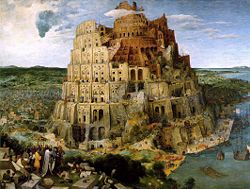
Belgium is well-known for its fine art and architecture. The region corresponding to today's Belgium has seen the flourishing of major artistic movements that have had tremendous influence over European art. The Mosan art, the Early Netherlandish, the Flemish Renaissance and Baroque painting, and major examples of Romanesque, Gothic, Renaissance and Baroque architecture, and the Renaissance vocal music of the Franco-Flemish School developed in the southern part of the Low Countries, are milestones in the history of art. Famous names in this classic tradition are Jan van Eyck, Pieter Brueghel the Elder, Peter Paul Rubens and Anthony van Dyck. This rich artistic production, often referred to as a whole as Flemish art, gradually declined during the second half of the 17th century. However, in the 19th and 20th centuries, many original artists appeared. Belgium has produced famous romantic, expressionist and surrealist painters; these include Egide Wappers, James Ensor, Constant Permeke and René Magritte. Belgium has a thriving contemporary art scene, with internationally renowned artists such as Jan Fabre and the painter Luc Tuymans.
In music, Adolphe Sax invented the saxophone in 1846. Henri Vieuxtemps, Eugène Ysaÿe and Arthur Grumiaux were major 19th- and 20th-century violinists. Perhaps the most famous Belgian composer of this time was César Franck. The first Belgian singer to successfully pursue an international career is the pioneer of varieté and pop music Bobbejaan Schoepen. Jazz musician Toots Thielemans is world famous, so is singer Jacques Brel. In rock/pop music, K's Choice, Hooverphonic, Front 242 and dEUS are well known (See also Music of Belgium).
In architecture, Victor Horta was a major initiator of the Art Nouveau style.
In literature, Belgium has produced several well-known authors, such as the poets Emile Verhaeren and novelists Hendrik Conscience, Georges Simenon and Suzanne Lilar. The poet and playwright Maurice Maeterlinck won the Nobel Prize in literature in 1911. The best known Franco-Belgian comics are The Adventures of Tintin by Hergé but many other major authors of comics have been Belgian, including Peyo (the smurfs), André Franquin, Edgar P. Jacobs and Willy Vandersteen.
More recently, notable Belgian cinema directors have emerged, most of them strongly influenced by French cinema. The absence of a major Belgian cinema company has forced them to emigrate or participate in low-budget productions. Belgian directors include André Delvaux, Stijn Coninx, Luc and Jean-Pierre Dardenne; actors include Jan Decleir, Marie Gillain; and films include Man Bites Dog (film) and The Alzheimer Affair. In the 1980s, Antwerp's Royal Academy of Fine Arts produced the important fashion trendsetters, the Antwerp Six.
Belgium has also contributed to the development of science and technology. Mathematician Simon Stevin, anatomist Andreas Vesalius and cartographer Gerardus Mercator are among the most influential scientists from the beginning of the Early Modern Age in the Low Countries. More recently, at the end of the 19th century, in applied science, the chemist Ernest Solvay and the engineer Zenobe Gramme have given their names to the Solvay process and the Gramme dynamo. Georges Lemaître is a famous Belgian cosmologist credited with proposing the Big Bang theory of the origin of the universe in 1927. Three Nobel Prizes in Physiology or Medicine have been awarded to Belgians: Jules Bordet in 1919, Corneille Heymans in 1938, and Albert Claude and Christian De Duve in 1974. Ilya Prigogine was awarded the Nobel Prize in Chemistry in 1977.
On December 1, 2005, Father Damien was chosen as the Greatest Belgian of all time by the Flemish VRT, whereas the Walloons chose Jacques Brel.
One cannot understand Belgian cultural life without considering the folk festivals, which play a major role in the country's cultural life. Examples are the Carnival of Binche and Aalst, the Ducasse of Ath, the procession of the Holy Blood in Bruges, the 15th-of-August festival in Liège, and the Walloon festival in Namur. A major non-official holiday is the Saint Nicholas Day, which commemorates the festival of the children and, in Liège, of the students.
Football and cycling are especially popular. Among the well known cyclists, Eddy Merckx won five Tours de France and is considered one of the best cyclists ever because of his numerous victories in the Tour as well as other bicycle races. Belgium has two current female tennis champions: Kim Clijsters and Justine Henin-Hardenne. The Spa-Francorchamps motor-racing circuit is considered one of the most challenging in the world and is home to the Belgian Grand Prix (a Formula One World Championship race) and a 24 hour saloon car race. Belgium's most notable racing driver is Jacky Ickx, winner of 8 Grands Prix and a (then) record 6 Le Mans 24hr races. (The record for most wins on Le Mans is now held by Tom Kristensen [Denmark] with 7 victories. The record was set in 2005)
Belgium is well known for its cuisine. Many highly ranked restaurants can be found in the high-impact gastronomic guides, such as the Michelin Guide. Brands of Belgian chocolate, like Neuhaus, and Godiva, are world renowned and widely sold (the less famous but high quality exclusive chocolates include names such as Wittamer and Marcolini). Even the cheapest and most popular brand, Leonidas, has earned a reputation for its quality. Belgium produces over 500 varieties of beer (see Belgian beer). The biggest brewery in the world by volume is Inbev based in Belgium (company previously known as Interbrew and makers of such beers as Stella Artois and Leffe, merged with the Brazilian brewery Ambev to become the world's biggest). Belgians have a reputation for loving waffles and french fries (both originate from Belgium). The national food is steak (or mussels) with french fries and lettuce.
See also
- Belgian colonial empire
- Constitution of Belgium
- Communications in Belgium
- Crime in Belgium
- Education in Belgium
- Foreign relations of Belgium
- List of Belgian municipalities by population
- List of Belgians
- List of Belgium-related topics
- Military of Belgium
- Public holidays in Belgium
- Sport in Belgium
- Tourism in Belgium
- Transportation in Belgium
- Belgian cuisine
- Belgian beer
- Belgian Grand Prix
Notes
ReferencesISBN links support NWE through referral fees
- ↑ CIA The World Factbook, 2005
- ↑ Belgian economy. Belgian federal ministry of Foreign Affairs, Foreign Trade and Development Cooperation.
- ↑ Nuttall encyclopedia
- ↑ Language dispute divides Belgium, BBC News, 13 May, 2005
- ↑ Election turnout in national lower house elections from 1960 to 1995, numbers from Mark N. Franklin's "Electoral Participation".
- ↑ Constitution of Belgium Art. 99
- ↑ Belgium's "rainbow" coalition sworn in, BBC News, 12 July, 1999
- ↑ Composition of the Chamber of Representatives, on the official homepage of the Chamber, in French
- ↑ Court rules Vlaams Blok is racist, BBC News, 9 November, 2004
- ↑ Dioxin contamination scandal hits Belgium: Effects spread through European Union and beyond, World Socialist Web Site, 8 June, 1999
- ↑ History of the Federal Food Agency, at its official homepage
- ↑ The Rwanda article at Tiscali.References shows an example of Belgium's recent African policies.
- ↑ The official homepage of Flanders (Community and Region)
- ↑ Eurometeo: The meteo at Brussels
- ↑ Pearce, Fred (2003-03-05). Sewage-laden Belgian water worst in world. New Scientist. Retrieved 2006-05-09.
- ↑ US Department of State's report
- ↑ [1].
- ↑ National Bank of Belgium
- ↑ 19.0 19.1 Official statistics of Belgium
- ↑ United Nation Development Programme
- ↑ 21.0 21.1 Ethnologue.com published by SIL International
- ↑ Statistics (PDF).
- ↑ International Religious Freedom Report 2004 at the US Department of State
- ↑ Inquiry by 'Vepec', 'Vereniging voor Promotie en Communicatie' (Organisation for Promotion and Communication), published in Knack magazine 22 November2006 p.14 [The Dutch language term 'gelovig' is in the text translated as 'religious', more precisely it is a very common word for believing in particular in any kind of God in a monotheistic sense, and/or in some afterlife].
- ↑ Digest of Education Statistics 2003, US National Education Statistics
- ↑ United Nation Development Programme
Sources
- Harvard Law School News: Bye bye Belgium? Entry on the future of Belgium published in the International Herald Tribune
- World history at KMLA
- Encyclopaedia Britannica, Belgium Country Page
- L'aménagement linguistique dans le monde in French by Jacques Leclerc, University of Laval, Canada
- Portal of the INS to statistical publications about Belgium
- CIA World Factbook entry on Belgium
- Constitution of Belgium
- English in Belgium
Bibliography
- Paul Arblaster. A History of the Low Countries. Palgrave Essential Histories Series New York: Palgrave Macmillan, 2006. 298 pp. ISBN 1-4039-4828-3.
- J. C. H. Blom and E. Lamberts, eds. History of the Low Countries (1999)
- Émile Cammaerts. A History of Belgium from the Roman Invasion to the Present Day (1921). 357 pages
- Demetrius Charles de Kavanagh Boulger. The History of Belgium: Part 1. Cæsar to Waterloo (2006 edition); Part 2. 1815-1865. Waterloo to the Death of Leopold (2001)
- B. A. Cook. Belgium: A History (2002)
- J. A. Kossmann-Putto and E. H. Kossmann. The Low Countries: History of the Northern and Southern Netherlands (1987)
External links
 Wikimedia Atlas of Belgium, holding maps related to Belgium.
Wikimedia Atlas of Belgium, holding maps related to Belgium.- Harvard Law School News: Bye bye Belgium? Entry on the future of Belgium published in the International Herald Tribune
- Official site of the Belgian federal government
- Belgian Tourist Office in the U.S.
- History of Belgium: Primary Documents
- Official site of Belgian tourist office
- Travel guide to Belgium from Wikitravel
- USC Center on Public Diplomacy Nation Profile
- Official website of Belgian monarchy
Albania · Andorra · Armenia2 · Austria · Azerbaijan1 · Belarus · Belgium · Bosnia and Herzegovina · Bulgaria · Croatia · Cyprus2 · Czech Republic · Denmark3 · Estonia · Finland · France3 · Georgia1 · Germany · Greece · Hungary · Iceland · Ireland · Italy · Kazakhstan1 · Latvia · Liechtenstein · Lithuania · Luxembourg · Republic of Macedonia · Malta · Moldova · Monaco · Montenegro · Netherlands3 · Norway3 · Poland · Portugal · Romania · Russia1 · San Marino · Serbia · Slovakia · Slovenia · Spain3 · Sweden · Switzerland · Turkey1 · Ukraine · United Kingdom3 · Vatican City
1 Has majority of its territory in Asia. 2 Entirely in Asia but having socio-political connections with Europe. 3 Has dependencies or similar territories outside Europe.
Credits
New World Encyclopedia writers and editors rewrote and completed the Wikipedia article in accordance with New World Encyclopedia standards. This article abides by terms of the Creative Commons CC-by-sa 3.0 License (CC-by-sa), which may be used and disseminated with proper attribution. Credit is due under the terms of this license that can reference both the New World Encyclopedia contributors and the selfless volunteer contributors of the Wikimedia Foundation. To cite this article click here for a list of acceptable citing formats.The history of earlier contributions by wikipedians is accessible to researchers here:
The history of this article since it was imported to New World Encyclopedia:
Note: Some restrictions may apply to use of individual images which are separately licensed.
